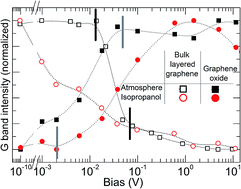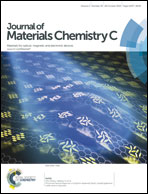Electron–phonon interaction in bulk layered graphene and its oxide in the presence of alcohols in a device: equilibrium molecular doping†
Abstract
We report on electron phonon interactions in bulk layered graphene (GRA) and its oxide (GO) under bias when exposed to 1° or 2° alcohol vapors, where we have focused on the change of Raman intensity of G and D bands as a function of the bias across the device. In addition to the softening of phonons we have observed a systematic variation in the intensity for D and G bands which is directly related to guest molecules and intrinsic surface nature of GRA and GO. Although the guest molecules withdraw electrons from GRA or GO, the intrinsic nature of the host material has caused mutually contrasting behaviour in IV-characteristics, where the conductance of the former decreases while it increases for the latter. The results from IV-spectra and the intensity maps of D and G bands are juxtaposed and the changes are analyzed with respect to surface and functional group interactions. In the context of doping, it is interesting to see that under equilibrium molecular charge transfer (top-gate like), the intensity ratios of 2D and G bands are not constant in contrast to a previous study [Phys. Rev. B., 2009, 80, 165413] in which such a ratio is invariant in the field effect configuration.


 Please wait while we load your content...
Please wait while we load your content...